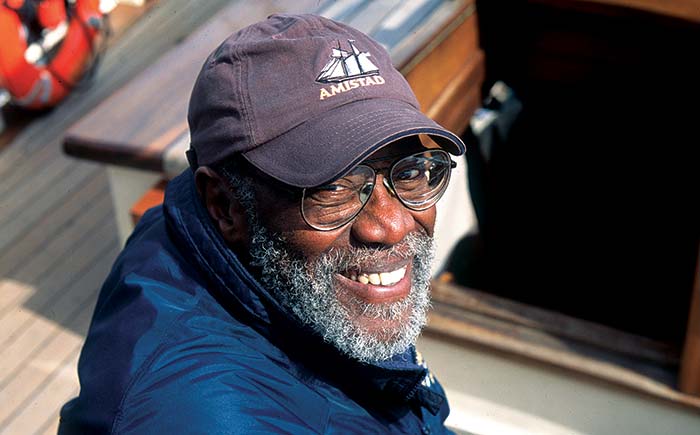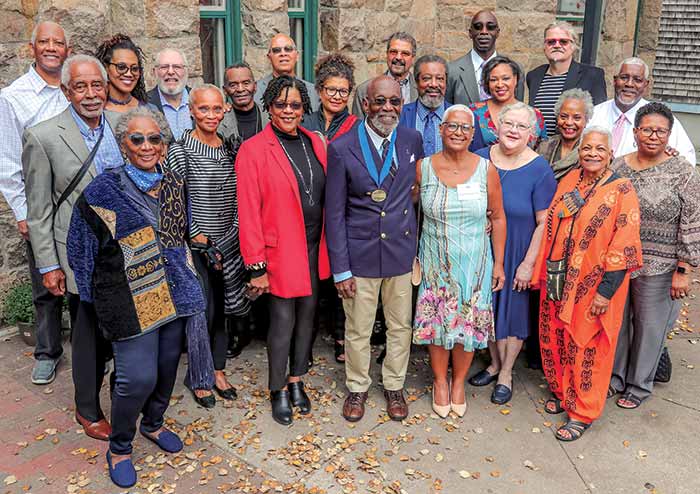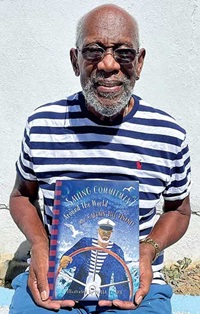Advertisement
A solo circumnavigation intended to inspire his grandkids evolved into a life-changing media event that stands as a testament to perseverance.

He skippered the cargo schooner Amistad, teaching thousands of visitors about the history of the 19th century ship, best known for its slave revolt. (Photo: Jonathan Atkin/Shipshooter.com)
Bill Pinkney's unique and extraordinary boating accomplishments earned him the National Sailing Hall of Fame's Lifetime Achievement Award in 2021. This now-87-year-old's landmark sailing accomplishment was a record-breaking two-year solo circumnavigation (1990–1992) aboard the 47-foot cutter Commitment, making him the first African-American sailor to circle the planet via the five great southern capes.
He recounts in his memoir, "As Long As It Takes," that as a young boy growing up in the part of Chicago called Bronzeville, he remembered hearing a depressing statistic: "As a Black male, educated in the public school system, raised partially on welfare, and brought up by a divorced woman, before I would turn 21 chances were I'd be on drugs, in jail, or dead from crimes of violence." He beat those odds, inspired by his strong mother "who taught me that I could become whatever I wanted if I was willing to work for it."
After high school, Pinkney joined the Navy, then became a marketing manager for Revlon, and went on to be a public information officer for the City of Chicago. When he finally set off sailing, his epic 22,000-mile voyage was followed by tens of thousands of public-school students in classrooms in Chicago and Boston, who used his trip to gain firsthand knowledge of geography, navigation, ecology, and oceanography.

Bill with wife, Migdalia (on right), along with family and friends at his National Sailing Hall of Fame induction. (Photo: Daniel Forster/National Sailing Hall of Fame)
Later, with his U.S. Merchant Marine Officer's license, Pinkney was named sailing master of Mystic Seaport's replica cargo schooner Amistad, and set out with a crew of teachers to trace the Middle Passage slave routes to the Americas. He skippered Amistad on voyages from Halifax, Nova Scotia, to Key West, Florida — during which thousands of visitors came aboard for hands-on history lessons — along with a historic visit to Cuba. There, Pinkney and Amistad took part in a ceremony in remembrance of the slave revolt that took place aboard the original ship in 1839. Here at home, he's been honored by senators and former presidents, and the account of this accomplishment was read into the Congressional Record.
From his home in Puerto Rico, where he lives with his wife, Migdalia, Pinkney spoke to BoatUS Magazine about his life's journey.
McCormick: How did you start sailing?
Pinkney: I grew up maybe a mile from Lake Michigan. In the summer, I'd go down and watch the boats. I always wondered what was on the other side of the lake. I joined the Navy because of that, because I wanted to get on the water. And unlike the other guys, who had fun in port, my greatest joy was when we got underway. I ended up on a ship based in Puerto Rico, then came back after I got out of the service. Most of the cargo ships there were island-built sailing vessels. I helped them load the boats, then ride over to Vieques or St. Thomas or the BVI, hang out for a while, and wait for another boat to come back. I loved that. I thought it was the greatest thing since milk and cookies.
Later, I was living in Manhattan [New York] and took a class at Steve Colgate's Offshore Sailing School where I learned the fundamentals. Steve was my first real tutor. I really started sailing when I moved back to Chicago and met a guy with a beautiful Swan 44. We did the Chicago-Mackinaw Race every year. Then I bought my first boat, a Pearson Triton, that I sailed by myself because I couldn't get crew. I loved that boat. So that love of the water has always been in me.

Bill Pinkney shares what it’s like to sail around the world with Sade Mall and Bailery Walker at Harvard-Kenty Kindergarten in Boston in 1992. (Photo: Richard Howard/The LIFE Picture Collection/Shutterstock)
It's quite a leap from sailing alone on Lake Michigan on a 28-footer to a solo circumnavigation via the Southern Ocean on an oceangoing Valiant 47. How did that happen?
My original plan was to sail around the world on a 35-footer as inspiration for my two grandchildren. It became something much bigger when I got some sponsorship, added an educational component, and ultimately developed a curriculum for school kids in Chicago and Boston. With some of the seed money, I went to England and was introduced to Robin Knox-Johnston, the first man to sail around the world without stopping. He's the top of the heap! If you're going to talk about solo sailing, I was meeting the lord! And he said, "Look, you're a Black guy. It's not going to be a big thing if you cross the Atlantic and go through the Panama and Suez canals. The day after you finish, another Black guy does the same voyage but around Cape Horn. They'll never know your name. If you're going to do it, do it like a bloody man!"
So the lord told me what to do! By the way, there was a Black guy who sailed around the world alone before me named Ted Seymour. But he went through the canals. The only recognition he ever got was a little plaque from the Seaman's Church in New York. That's it. So Robin was right.
That voyage took two years. What were the highlights?
My first experience in South Africa was incredible. Two weeks before I got there, Nelson Mandela was released from prison. I sailed past Robben Island, where he'd been imprisoned, flying a red, black, and green spinnaker, the colors of the African liberation movement. As an afterthought, I should've put a big yellow Star of David on there as well (laughing), because I'm Jewish. (Pinkney converted to Judaism after marriage to his first wife, Ina.) Everywhere I went, people were so curious about me, this Black guy in shorts with a T-shirt that says Commitment on it. I met so many wonderful people, and wound up staying longer than I'd planned.
Advertisement
What about the sailing? Were there any hairy moments?
My first knockdown. I'm in the Southern Ocean, broad reaching. I've got up a No. 2 jib and a reef in the main. It's blowing maybe 25 knots. I'm making 6 or 7, which is reasonable for me. Then ... BAM! 59 knots on the anemometer! These days we'd call it a microburst. I went rail down on the port side, then rolled back to starboard. A bottle of Vermont maple syrup goes flying. It's everywhere — on the bookshelf, the overhead, everywhere. It took two weeks to clean everything up.
It must've been a relief to wrap up that voyage. What was it like sailing back into Boston?

Captain Bill Pinkney arrives in Boston, and the history books,
after completing his solo circumnavigation. (Photo: Bill Pickney)
I come alongside the dock at Constitution Wharf and the commodore of my old yacht club in Chicago, the Belmont Yacht Club, is there to take my lines. Fantastic. The Navy band is playing. The chairman of the welcoming committee is Dodge Morgan (record-setting American solo sailor). I'd read his book "The Voyage of American Promise" a million times on the trip. I walk up a gangplank and as far as I can see, there are kids cheering, waving "Welcome Home" flags. Those kids blew me away. My adrenaline was going like mad.
I eventually get back to my boat and crash, then hear this knocking, and someone says, "Get dressed. It's time for the reception over on the Constitution!" I come up the gangway and turn and salute the ensign and officer of the deck. The loudspeaker goes, "Commitment. Arriving." I almost lost it. Here I am, an eight-year Navy vet, an enlisted man, getting piped aboard the oldest ship in the United States Navy. And my ship, that I'd just sailed around the world, is recognized as I come aboard — a mind-blower! Then the C.O. gave me the flag that was flying when I came in, and the shell casing (from a round that saluted me) mounted on a wooden base from a plank of the Constitution. They both sit on top of my bookshelf here, incredible mementos from the whole trip.
You've broken a lot of barriers, and continued to do so after your Commitment voyage, becoming the sailing master on Mystic Seaport's replica of the cargo ship Amistad. As you look at our sport, how do you see it evolving for people of color? What are the barriers, and how can they be overcome?
The general public doesn't see that there are many Black sailors out on the water. For over 20 years, the late Paul Mixon and myself have been taking Black sailors from all over the country sailing down in the BVI, chartering 20 or 30 boats from The Moorings or Voyage every year. There are Black sailing clubs and yacht clubs all over the country. Because we've done it on our own, we've not been part of the greater sailing community. Most people don't know we exist.
The Seafarers in Washington, D.C., have been involved in boats since the '60s. Chicago's Jackson Park Yacht Club has a program that's oversubscribed every year, teaching young people from the inner city how to sail. There are programs all over. They haven't been recognized or given the due that they should — that those sailors who look like me are a part of the greater sailing community. Maybe not in great numbers. But look at the greater population: We're a minority, but we're evolving and will continue to evolve.
We need to put sailing's image forward as a major sport, which it is. As a developmental and educational sport, which it is, and support and publicize these programs out there. I give kudos to the National Sailing Hall of Fame. At no time, in any place, have they ever mentioned me as a Black sailor. No place. Only as a sailor. And that's the identity that all of us who sail want. Religion, sexuality, color, none of that has anything to do with the fact that, first and foremost, we're sailors.

Photo: Bill Pinkney
Dream A Little Dream
From first page to last, Captain Bill Pinkney's captivating new book for children, "Sailing Commitment Around the World," is nothing less than a delight. Beautifully illustrated with full-color paintings by Pamela C. Rice, the book is most certainly a true-life adventure tale that takes young readers on a journey of discovery around the world. But it's also something even better: an inspirational story about a kid with a dream who ultimately had the courage and drive to fully realize it. With simple but memorable prose and a message with lessons learned that will resonate with readers young and old, Capt. Pinkney's Commitment wasn't just the name of his boat. It was the driving force behind a historic, once-in-a-lifetime voyage.
